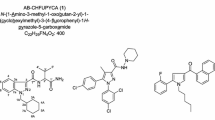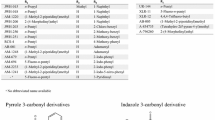Abstract
Two synthetic cannabinoid analogues were detected using high-performance liquid chromatography (HPLC)–diode array detector, and gas chromatography–time-of-flight-mass spectrometry during the inspection of illegal products in an airmail package. The analogues were separated by semi-preparative HPLC, and their structures were determined by performing liquid chromatography–high-resolution-mass spectrometry, infrared analysis, and nuclear magnetic resonance spectroscopy. Compound 1 was MDMB(N)-Bz-F, which has been reported previously. Compound 2 was elucidated as adamantan-1-yl 1-pentyl-1H-indazole-3-carboxylate (APINAC), in which the amide group of APINACA was replaced with an ester group. Because there has been no chemical or pharmacological data about this compound until now, this is the first report of its detection in illegal products.








Similar content being viewed by others
References
Huffman JW (2009) Cannabimimetic indoles, pyrroles, and indenes: structure-activity relationships and receptor interactions. In: Reggio PH (ed) The cannabinoid receptors. Humana Press, New York, pp 49–94
Benford DM, Caplan JP (2011) Psychiatric sequelae of spice, K2 and synthetic cannabinoid receptor agonists. Psychosomatics 52:295
Every-Palmer S (2010) Warning: legal synthetic cannabinoid-receptor agonists such as JWH-018 may precipitate psychosis in vulnerable individuals. Addiction 105:1859–1860
Gandhi AS, Zhu M, Pang S, Wohlfarth A, Scheidweiler KB, Liu HF, Huestis MA (2013) First characterization of AKB-48 metabolism, a novel synthetic cannabinoid, using human hepatocytes and high-resolution mass spectrometry. J AAPS 15:1091–1098
Spaderna M, Addy PH, D’Souza DC (2013) Spicing things up: synthetic cannabinoids. Psychopharmacology 228:525–540
Uchiyama N, Kawamura M, Kikura-Hanajiri R, Goda Y (2013) URB-754: a new class of designer drug and 12 synthetic cannabinoids detected in illegal products. Forensic Sci Int 227:21–32
Chung H, Choi H, Heo S, Kim E, Lee J (2014) Synthetic cannabinoids abused in South Korea: drug identifications by the 123 National Forensic Service from 2009 to June 2013. Forensic Toxicol 32:82–88
Uchiyama N, Kawamura M, Kikura-Hanajiri R, Goda Y (2012) Identification of two new-type synthetic cannabinoids, N-(1-adamantyl)-1-pentyl-1H-indole-3-carboxamide (APICA) and N-(1-adamantyl)-1-pentyl-1H-indazole-3-carboxamide (APINACA), and detection of five synthetic cannabinoids, AM-1220, AM-2233, AM-1241, CB-13 (CRA-13), and AM-1248, as designer drugs in illegal products. Forensic Toxicol 30:114–125
Vikingsson S, Josefsson M, Gre´en H (2015) Identification of AKB-48 and 5F-AKB-48 metabolites in authentic human urine samples using human liver microsomes and time of flight mass spectrometry. J Anal Toxicol 39:426–435
Thornton SL, Wood C, Friesen MW, Gerona RR (2013) Synthetic cannabinoid use associated with acute kidney injury. Clin Toxicol 51:189–190
Seely KA, Lapoint J, Moran JH, Fattore L (2012) Spice drugs are more than harmless herbal blends: a review of the pharmacology and toxicology of synthetic cannabinoids. Prog Neuropsychopharmacol Biol Psychiatry 29:234–243
Ashton AC (1999) Adverse effects of cannabis and cannabinoids. Br J Anaesth 83:637–649
Kronstrand R, Roman M, Andersson M, Eklund A (2013) Toxicological findings of synthetic cannabinoids in recreational users. J Anal Toxicol 37:534–541
Vardakou I, Pistos C, Spiliopoulou C (2010) Spice drugs as a new trend: mode of action, identification and legislation. Toxicol Lett 197:157–162
UNODC (2012) World drug report 2012. United Nations Office on Drugs and Crime, Vienna
Choi JY, Hea S, Yoo GJ, Park SK, Yoon CY, Baek SY (2015) Development and validation of an LC-MS/MS method for the simultaneous analysis of 28 specific narcotic adulterants used in dietary supplements. Food Addit Contam A 32:1029–1039
Penn HJ, Langman LJ, Unold D, Shields J, Nichols JH (2011) Detection of synthetic cannabinoids in herbal incense products. Clin Biochem 44:1163–1165
Harris CR, Brown A (2013) Synthetic cannabinoid intoxication: a case series and review. J Emerg Med 44:360–366
Grotenhermen F (2007) The toxicology of cannabis and cannabis prohibition. Chem Biodivers 4:1744–1769
Seely KA, Patton AL, Moran CL, Womack ML, Prather PL, Fantegrossi WE, Radominska-Pandya A, Endres GW, Channell KB, Smith NH, McCain KR, James LP, Moran JH (2013) Forensic investigation of K2, spice, and ‘‘bath salt’’ commercial preparations: a 3-year study of new designer drug products containing synthetic cannabinoid, stimulant, and hallucinogenic compounds. Forensic Sci Int 233:416–422
Kikura-Hanajiri R, Uchiyama N, Kawamura M, Goda Y (2013) Changes in the prevalence of synthetic cannabinoids and cathinone derivatives in Japan until early 2012. Forensic Toxicol 31:44–53
Namera A, Kawamura M, Nakamoto A, Saito T, Nagao M (2013) Comprehensive review of the detection methods for synthetic cannabinoids and cathinones. Forensic Toxicol 33:175–194
Uchiyama N, Kikura-Hanajiri R, Kawahara N, Haishima Y, Goda Y (2009) Identification of a cannabinoid analog as a new type of designer drug in a herbal product. Chem Pharm Bull 57:439–441
Amato J, Iaccarino N, Pagano B, Compagnone V, Di Rosa F, Peluso G, Novellino E, Randazzo A (2014) NMR assignment of N-(1-adamantyl)-1-pentyl-1H-indazole-3-carboxamide seized as herbal incense for the first time in Italy. J Forensic Sci Criminol 2(1):103. doi:10.15744/2348-9804.1.403
EMCDDA (2015) New psychoactive substances in Europe: an update from the EU early warning system. European Monitoring Centre for Drugs and Drug Addiction. http://www.emcdda.europa.eu/publications/2015/new-psychoactive-substances. Accessed 8 June 2016
Shevyrin V, Melkozerov V, Nevero A, Eltsov O, Shafran Y, Morzherin Y, Lebedv AT (2015) Identification and analytical characteristics of synthetic caanabinoids with an indazole-3-carboxamide structure bearing a N-1-methoxycarbonylalkyl group. Anal Bioanal Chem 407:3601–3615
Uchiyama N, Matsuda S, Kawamura M, Kikura-Hanajiri R, Goda Y (2013) Two new-type cannabimimetic quinolinyl carboxylates, QUPIC and QUCHIC, two new cannabimimetic carboxamide derivatives, ADB-FUBINACA and ADBICA, and five synthetic cannabinoids detected with a thiophene derivative α-PVT and an opioid receptor agonist AH-7921 identified in illegal products. Forensic Toxicol 31:223–240
Acknowledgments
This research was supported by Research Grants (15181MFDS521 and 15182MFDS523) from the Ministry of Food and Drug Safety (MFDS) in Korea. We thank the Central Laboratory of Kangwon National University for providing us with technical assistance on the spectroscopic experiments.
Author information
Authors and Affiliations
Corresponding authors
Ethics declarations
Conflict of interest
The authors declare that they have no conflict of interest.
Ethical approval
This article does not contain any studies with human participants or animals performed by any of the authors.
Additional information
J. H. Lee and H. N. Park contributed equally.
Electronic supplementary material
Below is the link to the electronic supplementary material.
Rights and permissions
About this article
Cite this article
Lee, J.H., Park, H.N., Leem, TS. et al. Identification of new synthetic cannabinoid analogue APINAC (adamantan-1-yl 1-pentyl-1H-indazole-3-carboxylate) with other synthetic cannabinoid MDMB(N)-Bz-F in illegal products. Forensic Toxicol 35, 45–55 (2017). https://doi.org/10.1007/s11419-016-0331-z
Received:
Accepted:
Published:
Issue Date:
DOI: https://doi.org/10.1007/s11419-016-0331-z




